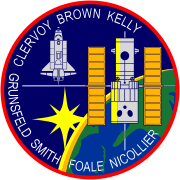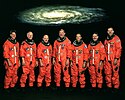STS-103
| STS-103 | |||||
 | |||||
| Uppdrag | 96 | ||||
|---|---|---|---|---|---|
| Rymdfärja | Discovery (27)[1] | ||||
| NSSDC-ID | 1999-069A[2] | ||||
| Färdens tid | 7 dagar, 23 timmar, 11 minuter, 34 sekunder | ||||
| Uppskjutning | |||||
| Startplats | Startplatta 39A vid Kennedy Space Center i Florida | ||||
| Start | 19 december 1999 7:50:00.069 p.m. EST | ||||
| Landning | |||||
| Landningsplats | KSC, Runway 33 | ||||
| Landning | 27 december 1999 7:01:34 p.m. EST | ||||
| Omloppsbana | |||||
| Varv | 119 st[3] | ||||
| Banlutning | 28,5° | ||||
| Sträcka | 5,23 miljoner km | ||||
| Rymdpromenad | |||||
| Antal | 3 st | ||||
| Total tid | 24 timmar, 33 minuter | ||||
| Besättning | |||||
| Befälhavare | Curtis L. Brown (6) | ||||
| Pilot | Scott J. Kelly (1) | ||||
| Uppdragsspecialister | Steven L. Smith (3) C. Michael Foale (5) John M. Grunsfeld (3) Claude Nicollier (4) ESA Jean-François Clervoy (3) ESA Frankrike | ||||
 | |||||
| Kronologi Rymdfärjeprogrammet | |||||
| |||||
STS-103 var en rymdfärjeflygning i det amerikanska rymdfärjeprogrammet. Det var den tjugosjunde flygningen med Discovery. Den sköts upp från Pad 39B vid Kennedy Space Center i Florida den 19 december 1999. Efter nästan åtta dagar i omloppsbana runt jorden återinträdde rymdfärjan i jordens atmosfär och landade vid Kennedy Space Center.
Uppdraget var att serva Rymdteleskopet Hubble.
Rymdpromenader
Under flygningens tre rymdpromenader bytte man bland annat ut flera av rymdteleskopets gyroskop.
Statistik
Besättning
- Curtis L. Brown (6), befälhavare
- Scott J. Kelly (1), pilot
- Steven L. Smith (3), uppdragsspecialist
- C. Michael Foale (5), uppdragsspecialist
- John M. Grunsfeld (3), uppdragsspecialist
- Claude Nicollier (4), uppdragsspecialist
- Jean-François Clervoy (3), uppdragsspecialist
Väckningar
Under Geminiprogrammet började NASA spela musik för besättningar och sedan Apollo 15 har man varje "morgon" väckt besättningen med ett musikstycke, särskilt utvalt antingen för en enskild astronaut eller för de förhållanden som råder.
| Dag | Låt | Artist/Kompositör |
|---|---|---|
| 2 | "Takin' Care of Business" | Bachman-Turner Overdrive |
| 3 | "Rendezvous" | Bruce Springsteen |
| 4 | "Hucklebuck" | Beau Jocque and the Zydeco Hi-Rollers |
| 6 | "Magic Carpet Ride" | Steppenwolf |
| 7 | "I'll Be Home for Christmas" | Bing Crosby |
| 8 | "We’re So Good Together" | Reba McEntire |
| 9 | "La copa de la vida" | Ricky Martin |
Se även
Referenser
- ^ NASA Space Shuttle Launch Archive Arkiverad 15 augusti 2011 hämtat från the Wayback Machine., läst 28 juli 2016.
- ^ ”NASA Space Science Data Coordinated Archive” (på engelska). NASA. https://nssdc.gsfc.nasa.gov/nmc/spacecraft/display.action?id=1999-069A. Läst 22 mars 2020.
- ^ Manned Astronautics - Figures & Facts Arkiverad 4 mars 2016 hämtat från the Wayback Machine., läst 28 juli 2016.
Externa länkar
 Wikimedia Commons har media som rör STS-103.
Wikimedia Commons har media som rör STS-103.
| ||||||||||||||||||||||||||||||
| ||||||||
| ||||||||||||||||||||||||||||||||
Media som används på denna webbplats
STS099-(S)-001 (JUNE 1999) STS-99 INSIGNIA -- The crew members designed the flight insignia for the Shuttle Radar Topography Mission (SRTM), the most ambitious Earth mapping mission to date. Two radar antennas, one located in the Shuttle bay and the other located on the end of a 60-meter deployable mast, will be used during the mission to map Earth's features. The goal is to provide a 3-dimensional topographic map of the world's surface up to the Arctic and Antarctic Circles. The clear portion of Earth illustrates the radar beams penetrating its cloudy atmosphere and the unique understanding of the home planet that is provided by space travel. The grid on Earth reflects the mapping character of the SRTM mission. The patch depicts the Space Shuttle Endeavour orbiting Earth in a star spangled universe. The rainbow along Earth's horizon resembles an orbital sunrise. The crew deems the bright colors of the rainbow as symbolic of the bright future ahead because of human beings' venturing into space.
Författare/Upphovsman: Pascal (Flickr user: pasukaru76), Licens: CC0
Vostok spacecraft replica at the Technik Museum Speyer, Germany.
The Hubble Space Telescope as seen from the departing Space Shuttle Atlantis, flying STS-125, HST Servicing Mission 4.
STS093 (S)-001 (Sept. 1998) --- The STS-93 mission patch, as designed by the five crew members. The STS-93 mission will carry the Advanced X-ray Astrophysics Facility (AXAF) into low Earth orbit initiating its planned five-year astronomy mission. AXAF is the third of NASA's great observatories, following the Hubble Space Telescope and the Compton Gamma Ray Observatory. AXAF will provide scientists an order-of-magnitude improvement over current capabilities at X-ray wavelengths. Observations of X-ray emissions from energetic galaxies and clusters, as well as black holes, promise to greatly expand current understanding of the origin and evolution of our universe. The STS-93 patch depicts AXAF separating from the Space Shuttle Columbia after a successful deployment. A spiral galaxy is shown in the background as a possible target for AXAF observations. The two flags represent the international crew, consisting of astronauts from both the United States and France. The NASA insignia design for Shuttle flights is reserved for use by the astronauts and for other official use as the NASA Administrator may authorize. Public availability has been approved only in the form of illustrations by the various news media. When and if there is any change in this policy, which we do not anticipate, it will be publicly announced.
Designed by the crewmembers, the STS-103 emblem depicts the Space Shuttle Discovery approaching the Hubble Space Telescope (HST) prior to its capture and berthing. The purpose of the mission is to remove and replace some of the Telescope's older and out-of-date systems with newer, more reliable and more capable ones, and to make repairs to HST's exterior thermal insulation that has been damaged by more than nine years of exposure to the space environment. The horizontal and vertical lines centered on the Telescope symbolize the ability to reach and maintain a desired attitude in space, essential to the instrument's scientific operation. The preservation of this ability is one of the primary objectives of the mission. After the flight, the Telescope will resume its successful exploration of deep space and will continue to be used to study solar system objects, stars in the making, late phases of stellar evolution, galaxies and the early history of the universe. HST, as represented on this emblem was inspired by views from previous servicing missions, with its solar arrays illuminated by the Sun, providing a striking contrast with the blackness of space and the night side of Earth.
- The NASA insignia design for Shuttle flights is reserved for use by the astronauts and for other official use as the NASA Administrator may authorize. Public availability has been approved only in the form of illustrations by the various news media. When and if there is any change in this policy, which is not anticipated, it will be publicly announced.
These seven astronauts have been assigned as crew members for NASA's third servicing mission to the Hubble Space Telescope (HST). They are, from the left, astronauts C. Michael Foale, Claude Nicollier, Scott J. Kelly, Curtis L. Brown, Jr., Jean-Francois Clervoy, John M. Grunsfeld and Steven L. Smith. Brown and Kelly are commander and pilot, respectively. All the others are mission specialists (MS), with international MS Nicollier and Clervoy representing the European Space Agency (ESA).









